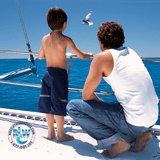
Nobody wants to buy a paddle board and feel like they don’t know how to use it properly. When you first begin paddle boarding, there are many mistakes that you can potentially make that can be detrimental to your health and the condition of your new board. Whether you have purchased a stand-up paddle board, or have rented one at your local lake, check out our tips for getting started with your new paddle board. Keep reading to learn more, and then go out and get on the water!
Use a Leash
It doesn’t matter if it is your first time paddle boarding or your 1,000th time; using a leash is imperative to your safety. Using a leash not only helps keep you safe but also keeps those around you safe. You also don’t have to stress about losing your board, as great paddle boards can be costly.
Hold Your Paddle the Right Way
Holding the paddle correctly will help you get the most out of each stroke in the water. You want the paddle to scoop the water as you try to balance and paddle without falling in. To achieve this, hold the paddle with your hands about shoulder-width apart. As you perform the stroke, the blade should be vertical in the water, providing the best angle for the most power. This also results in smoother strokes and less stress on your shoulders and elbows.
Face the Right Direction
If you are a non-surfer, you may need to know which end of your paddle board is the front/nose of the board. Many beginner boards have a large round nose and are tall, which allows for excellent stability.
So before you jump on the board, check where the fins are and make sure they are in the back when you paddle! Keeping the fins at the back help keep the board straight while you paddle and make your overall experience more enjoyable!
Paddle With Your Core
Avoid paddling with your arms at all costs. This may sound strange but trust us. Paddling with your core is the key to success when paddleboarding. The muscles in your core are the strongest in your body and provide the most effective power for your strokes. Think of your arms as merely assisting your paddling rather than doing all the work.
Fall the Right Way
When paddle boarding, especially if you are just starting out, chances are you will fall. Just like how you can practice tricks and riding waves, you need to practice falling! Yes, falling. If you do not fall off your board correctly, you may injure yourself or others around you. The key to falling correctly is to fall away from your board. Clearing the board when you fall will let you collapse gracefully into the water and not hit your head on the board. Don’t worry about losing your board; if you’re using the leash as we recommend, the board won’t go anywhere.
Take Care of Your Board & Paddle
Taking care of your equipment is imperative to having a great time and your ability to paddle board safely. Paddleboards and paddles are both fragile pieces of equipment, and you want to protect and take care of your investments!
Are you considering taking on an adventure and embarking on a paddleboard journey? Boat Lift Warehouse is your destination for both board and paddles. Browse our Kayaks and boards section and find your next paddle and board today!
This article was originally published in June of 2017 and has been updated for accuracy and relevancy.



